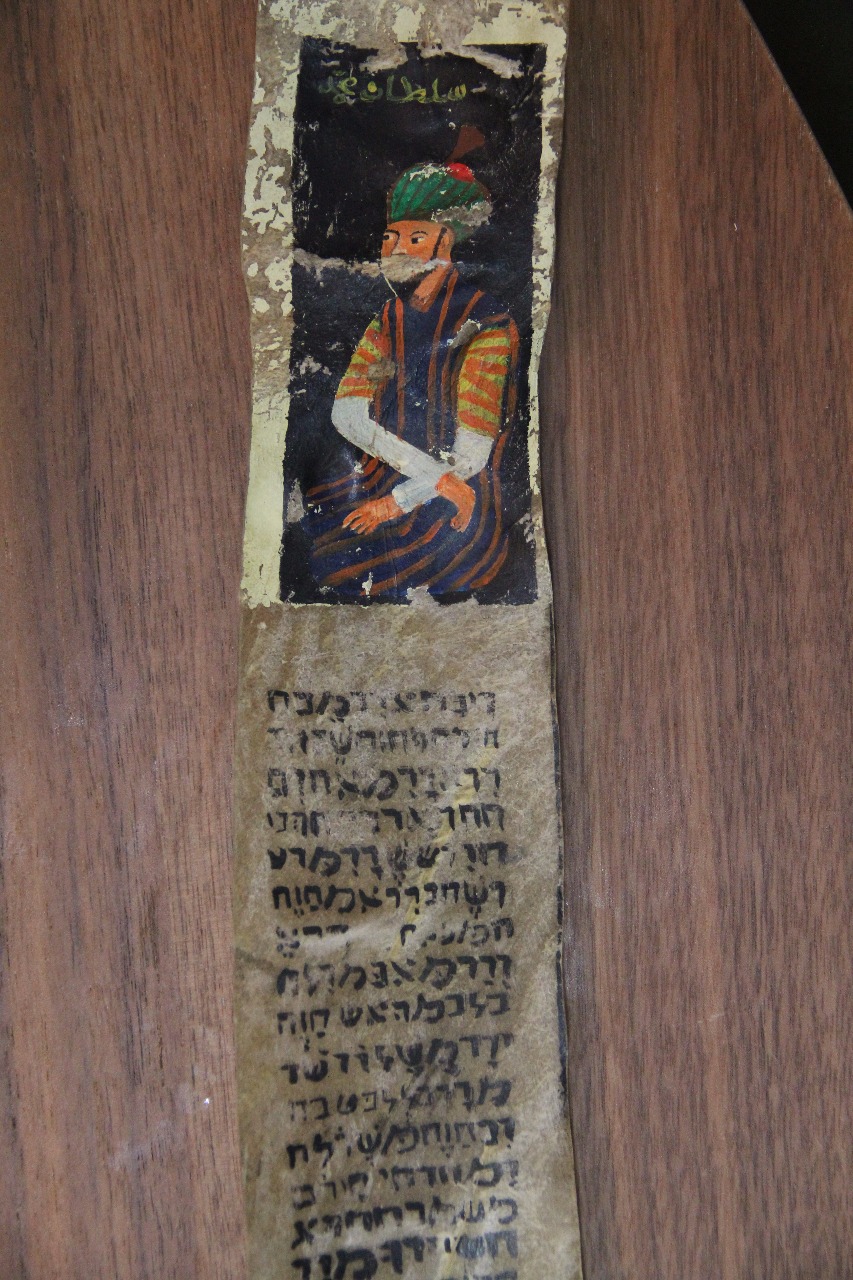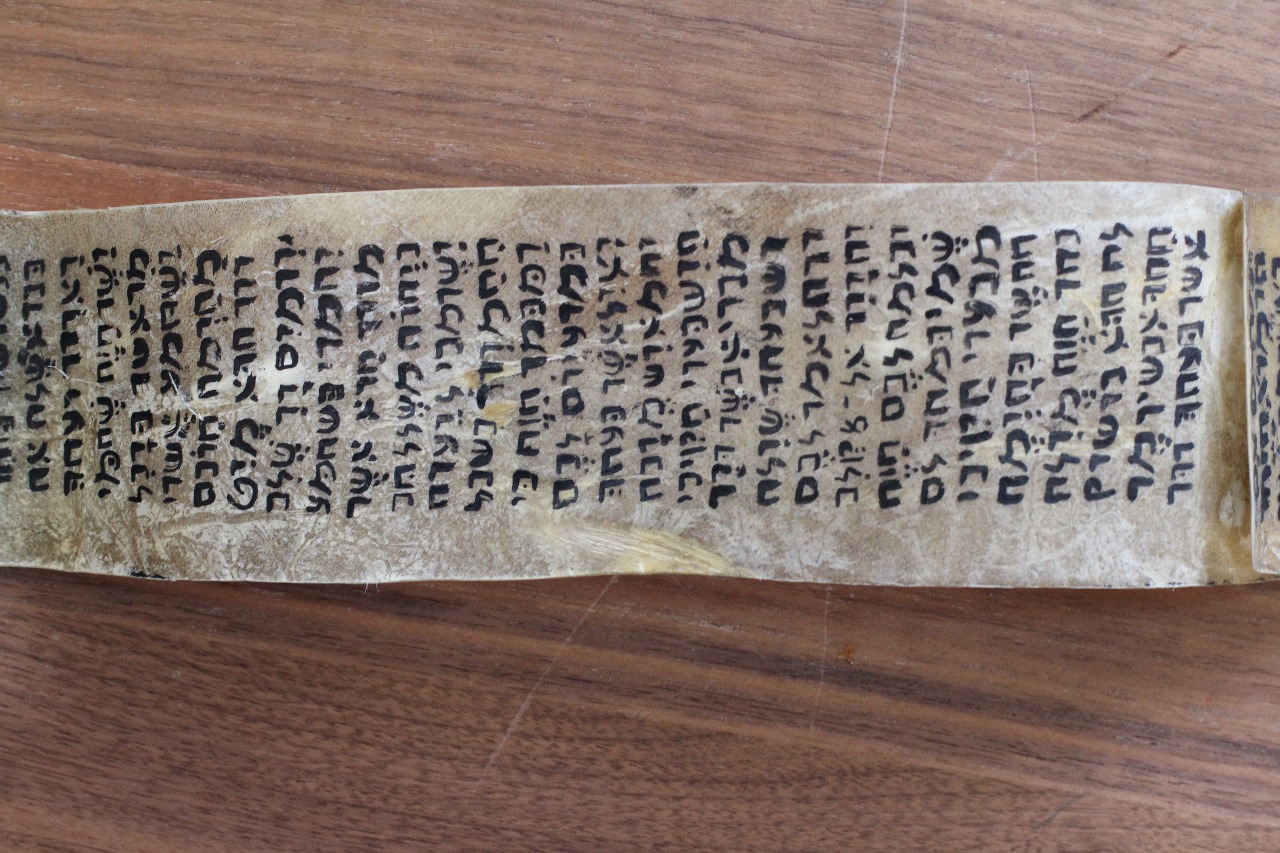Ottoman Hebrew scroll
« previous post | next post »
Or so it would seem, but the people who have looked at this scroll so far cannot make much sense of what's written on it.
Michael Carasik, who passed this on to me says, "The Arabic label above the picture may actually be readable, unlike the Hebrew, which is only sporadically so."
Can anybody read it?
[Thanks to Barry Schwartz]


Theophylact said,
February 15, 2018 @ 8:00 pm
I'n not a Semitic scholar, but Maimonides, for one, wrote in Judeo-Arabic : Arabic rendered into Hebrew letters.
Eden said,
February 15, 2018 @ 8:03 pm
I replied on Twitter, but will also here:
from this tiny photo, I can make out this as the arabic on the top:
سلطان محمّد
being "Sultan Muhammad"
Michael Becker said,
February 15, 2018 @ 8:20 pm
Looks like jibberish to me. Not Arabic, not Turkish, not Persian.
Victor Mair said,
February 15, 2018 @ 8:42 pm
@Eden
"tiny photo"
Click on the photos. The "embiggen" feature works well.
Emily Kapor-Mater said,
February 15, 2018 @ 9:05 pm
Doesn't look like Judeo-Arabic or Ladino; looks like Hebrew with an awful lot of misspellings and gibberish. Definitely has some intelligible words ("asher", "lachem", "ra[ḥ]amim")…but a whole heck of a lot of nonsense. My money would be on magical amulet-type thing.
David Erschler said,
February 15, 2018 @ 9:23 pm
I second what Emily said. (The text also contains the Tetragrammaton, which is quite likely in an amulet, I think.)
Levantine said,
February 15, 2018 @ 11:51 pm
If the scroll is indeed Ottoman, then the text at the very top should be read "Sultan Meh[em]med" rather than "Sultan Muhammad". The figure, however, doesn't much look like an Ottoman sultan.
phspaelti said,
February 16, 2018 @ 1:30 am
About "embiggen": The problem with that feature is that it tends to be limited by the dimensions of your browser window. So on my laptop a vertical photo like this one is barely "embiggened" at all.
I would recommend opening the image in a separate tab/window. That way you can enlarge the picture beyond the size of the display.
Stephen Goranson said,
February 16, 2018 @ 4:48 am
I unofficially guess it's a modern fake.
Luc said,
February 16, 2018 @ 6:07 am
@Stephen Goranson
There's also the possibility that it's a historical fake (I'd suggest pre-WWI). "Sultan Muhammad" plus Hebrew feels like something an Ottoman forger would use to try to pull one over on ignorant Christians, or, alternately, some kind of weird mysticism.
Ellen Kozisek said,
February 16, 2018 @ 8:43 am
@Victor
Clicking on the top photo doesn't make it bigger on my computer. A very slight bit smaller, actually. To make it bigger, I have to right click and open it in another window. And then, to see it full size, I have to click on it. (Also works on maximizing viewing size of the bottom picture. Though that one, being shorter in height, does get bigger by clicking on it.)
Noam Sienna said,
February 16, 2018 @ 10:22 am
This is a modern fake, made for the tourist trade. I see this kind of stuff from Morocco, Egypt, Turkey all the time. It's copied from real Hebrew text but the artist has no idea what they're reading, so the letters get mixed up. It's definitely not an amulet or anything like that.
Jack sasson said,
February 16, 2018 @ 11:28 am
Fake or not, there was a Sultan Muhammad who was a famous Savafid miniaturist (16c). Maybe it was supposed to have been his portrait. There may have been no connection between between this and the "Hebrew."
Stephen Goranson said,
February 16, 2018 @ 12:14 pm
Speaking of fakes, Dead Sea Discoveries (2017) v. 24 issue 2 makes a good case that some "Dead Sea Scroll" fragments sold since 2002 are fake.
A 2016 book, Splendide Mendax: Rethinking Fakes and Forgeries…, takes the view that some fakes are interesting nonetheless; I briefly reviewed it at amazon.
The "Angel Scroll" published in part in Jerusalem Report (Oct. 11, 1999) came with a weird provenance claim involving Benedictines; I wonder if that story was influenced by the 1972 F. Wiseman film "Essene."
The "Gabriel Vision," written on stone, and, like the "Angel Scroll," said (without proof) to be from Jordan, happened to appear after the 2003 publication of a genuine (excavated) small text from Qumran inked on limestone.
Michael said,
February 16, 2018 @ 12:54 pm
Definitely gibberish. If some short "words" resemble Hebrew words, that is a coincidence.
Ethan said,
February 21, 2018 @ 11:36 am
I'm pretty sure the first line translates to "Lorem ipsum dolor sit amet"
Michael Koplow said,
February 26, 2018 @ 1:31 pm
I'm not an expert in any of this stuff and am not competent to make any judgment on the item. But it's amazing to me that all these people are dismissing it as gibberish because it's not any language that they're familiar with. Before anyone gets on my case, I'm not saying it *isn't* gibberish.